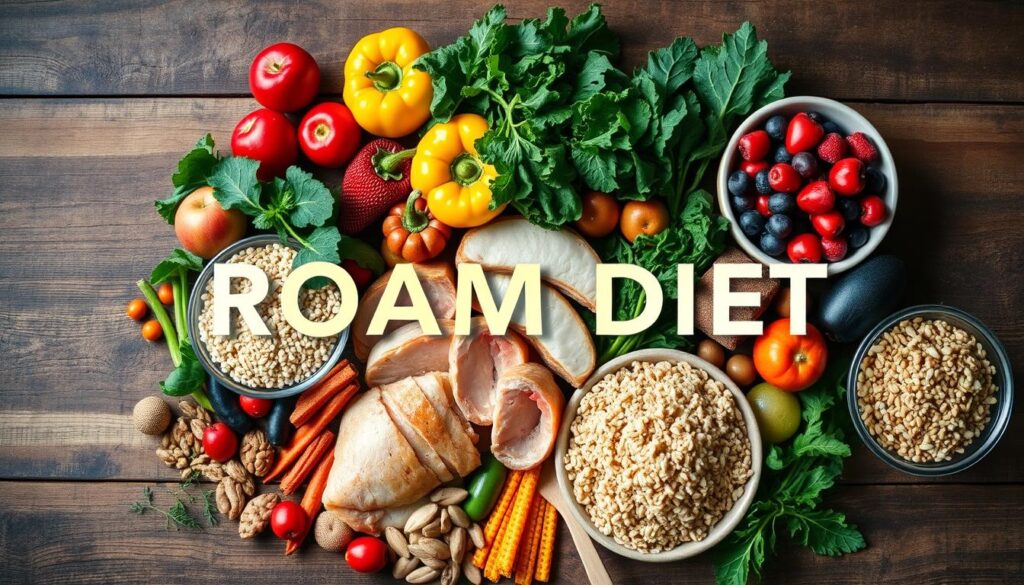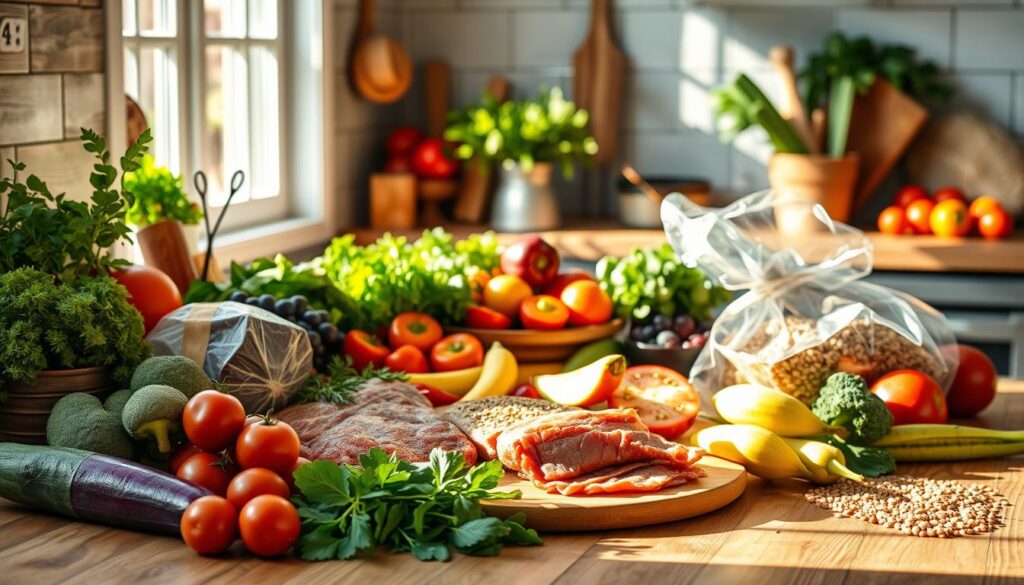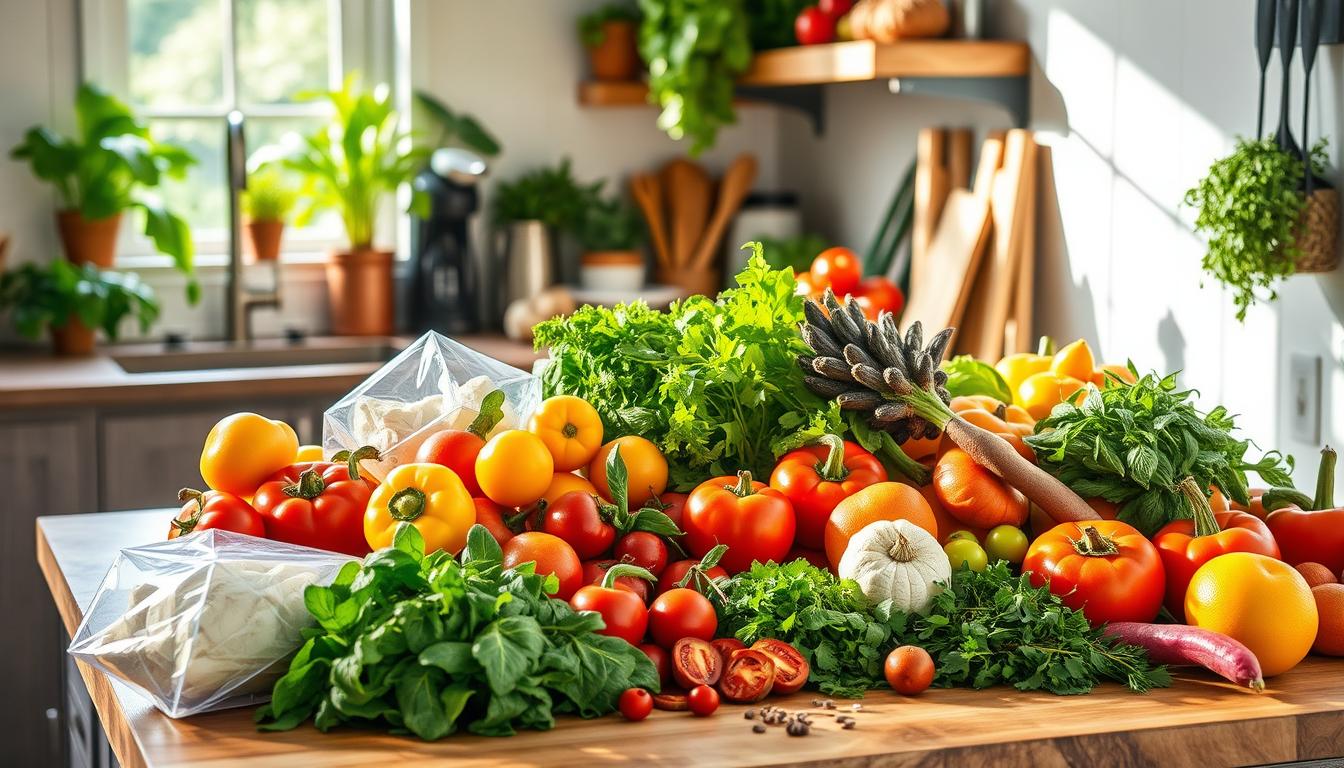The ROAM diet is a new way to eat. It changes how we think about food, health, and the planet. It uses fresh, local foods to make meals that are good for you and the earth.
This diet is all about eating fresh, local foods. It means eating whole foods and less processed stuff. It helps you stay healthy and supports local farmers and the planet.
Imagine making meals that are not only yummy but also good for you. With seasonal ingredients from local sources, you can make tasty, healthy dishes. These dishes will keep you full of energy and happy.
Key Takeaways
- Prioritize seasonal, locally sourced ingredients
- Reduce processed food consumption
- Support local farmers and economies
- Enhance nutritional intake through whole foods
- Minimize environmental impact through mindful eating
- Promote personal health through nutrient-dense meals
Understanding the ROAM Diet Principles and Benefits
The ROAM Diet is a new way to eat that’s different from old habits. It focuses on eating foods that are in season and local. This diet helps people feel better and connect with nature and their food.
Seasonal and Local Food Choices
Eating foods that are in season means you get the best taste and health benefits. Choosing local foods is key in the ROAM Diet. It has many good points:
- Maximizes nutrient density of fresh produce
- Supports local farmers and community businesses
- Reduces carbon footprint from transportation
- Provides fresher, more flavorful ingredients
Health Benefits of Natural Eating
The ROAM Diet is good for your health. Studies show it can help a lot:
- Improved digestion (up to 95% of participants report positive changes)
- Enhanced weight management
- Stabilized energy levels
- Reduced risk of chronic diseases by up to 40%
“Food is not just nutrition; it’s a connection to our environment and personal well-being.” – Nutrition Expert
Environmental Impact and Sustainability
The ROAM Diet is also good for the planet. It uses local and seasonal foods to help the environment. This way, it cuts down on pollution and supports green farming.
Key environmental benefits include:
- 50% lower greenhouse gas emissions compared to industrial farming
- Improved soil health and biodiversity
- Minimal antibiotic use in food production
- Support for humane animal treatment
Essential Ingredients for ROAM Diet Success

Starting a ROAM diet means picking the best whole foods and unprocessed items. It’s all about eating natural foods that make your body strong and healthy.
“Eat foods that your grandmother would recognize as real food.”
Here are the main ingredients for the ROAM diet:
- Fresh seasonal produce with high nutritional value
- Lean proteins from grass-fed and free-range sources
- Whole grains like quinoa, brown rice, and millet
- Raw nuts and seeds packed with essential nutrients
- Organic eggs and dairy from pasture-raised animals
Choose local and organic foods for the ROAM diet. Grass-fed meats and wild-caught fish are better than regular ones.
| Food Category | Recommended Choices | Protein Content |
|---|---|---|
| Plant Proteins | Chickpeas | 38% |
| Legumes | White Beans | 22% |
| Dairy Protein | Halloumi | 20% |
It’s important to avoid processed foods in the ROAM diet. Always check labels for fewer additives and preservatives.
Popular ROAM Diet Recipes for Every Meal
Discovering tasty and healthy meals is key to the ROAM diet. Our ROAM diet recipes make sure you don’t miss out on flavor. And you stay healthy too.

Each recipe uses whole foods, fresh ingredients, and balanced nutrition. We aim to make meals that fill you up and help your health.
Energizing Breakfast Recipes
Begin your day with ROAM diet breakfasts that give you energy and nutrients. Here are some yummy choices:
- Chia Seed Smoothie Bowl with Mixed Berries
- Vegetable Frittata with Fresh Herbs
- Quinoa Porridge with Seasonal Fruits
Wholesome Lunch and Dinner Selections
ROAM diet meals for lunch and dinner are balanced and tasty. Check out recipes that mix lean proteins, whole grains, and colorful veggies.
| Meal Type | Key Ingredients | Preparation Time |
|---|---|---|
| Lunch | Quinoa, Roasted Vegetables, Lemon-Tahini Dressing | 25 minutes |
| Dinner | Grilled Salmon, Steamed Asparagus, Brown Rice | 30 minutes |
Healthy Snacks and Sweet Treats
Healthy ROAM snacks keep your energy up between meals. Try these:
- Walnut and Apple Combo
- Homemade Trail Mix
- Fresh Vegetable Sticks with Herb Dip
“Eating should be a celebration of natural, wholesome ingredients that nourish both body and soul.”
With these ROAM diet recipes, healthy eating is easy and fun. Just remember to prepare, be creative, and choose whole, nutrient-rich foods.
Conclusion
The ROAM diet is more than a quick trend. It’s a way to feed your body and help our planet. It connects what you eat to how it affects the earth.
Starting the ROAM diet is easy. You don’t need to change everything at once. Just small steps can make a big difference. Try using fresh, local foods and making healthy meals.
This diet is flexible. It works for everyone, no matter what you like to eat. It focuses on whole foods, lean proteins, and veggies. This helps you stay healthy and eat less processed food.
Every meal is a chance to get healthier and help the planet. See the ROAM diet as a way to live better. It connects you to your food and the world.
FAQ
What exactly is the ROAM diet?
The ROAM diet is about eating foods that are local and fresh. It means eating foods that are in season. This diet helps you stay healthy and good for the planet.
How does seasonal eating work in the ROAM diet?
Seasonal eating means eating foods that are in season. You choose foods that grow near you. This makes food more nutritious, helps local farmers, and cuts down on pollution.
Is the ROAM diet expensive to follow?
Buying local and organic can cost more. But, the ROAM diet can be affordable. You can save money by buying in season and avoiding processed foods.
Can I follow the ROAM diet if I have dietary restrictions?
Yes, the ROAM diet is flexible. It works for many diets, like vegetarian or gluten-free. You can make it fit your needs by choosing whole, local foods.
How does the ROAM diet impact the environment?
The ROAM diet helps the planet a lot. It cuts down on pollution, supports local farms, and reduces waste. Eating local foods is good for the earth and your community.
What are the primary health benefits of the ROAM diet?
The ROAM diet is great for your health. It improves digestion, gives you energy, helps with weight, and reduces bad additives. You get natural, fresh nutrients from whole foods.
How can I start transitioning to the ROAM diet?
Start by adding local foods to your meals. Visit farmers markets and learn about local produce. Replace processed foods with natural ones. Small steps make it easier and fun.
Are there any challenges in maintaining the ROAM diet?
Yes, there might be challenges. Prices for organic foods can be high, and you might need to plan more. But, with a little creativity and planning, you can overcome these.
Can children and athletes follow the ROAM diet?
Absolutely! The ROAM diet is good for everyone, no matter their age or activity level. Make sure kids and athletes get enough protein and variety. Always talk to a nutritionist for specific needs.
How does the ROAM diet differ from other diet plans?
The ROAM diet is different because it’s about more than just food. It’s about living a healthy, sustainable lifestyle. It’s flexible and focuses on whole foods and eating with the seasons.

